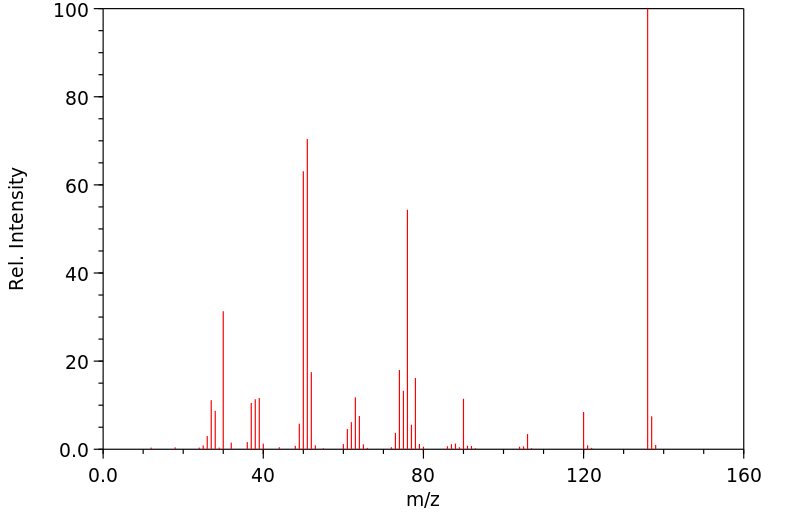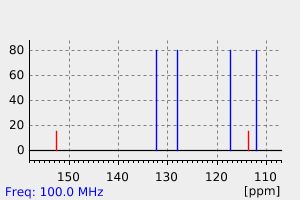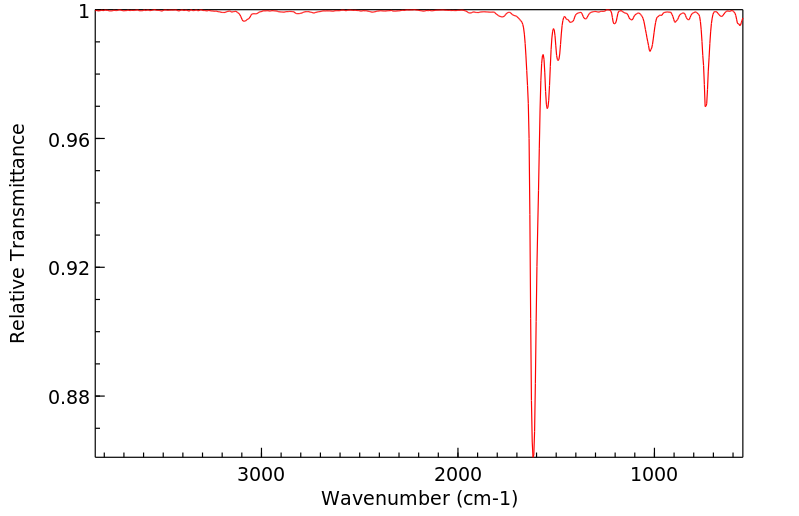苯并呋咱 | 480-96-6
中文名称
苯并呋咱
中文别名
苯并氧化呋咱;苯并-2,1,3-恶二唑-1-氧化物
英文名称
benzofurazan oxide
英文别名
benzofuroxan;1-oxo-1,7a-dihydrobenzo[c][1,2,5]oxadiazol-1-ium;3-oxido-2,1,3-benzoxadiazol-3-ium
CAS
480-96-6
化学式
C6H4N2O2
mdl
MFCD00005807
分子量
136.11
InChiKey
OKEAMBAZBICIFP-UHFFFAOYSA-N
BEILSTEIN
——
EINECS
——
-
物化性质
-
计算性质
-
ADMET
-
安全信息
-
SDS
-
制备方法与用途
-
上下游信息
-
文献信息
-
表征谱图
-
同类化合物
-
相关功能分类
-
相关结构分类
物化性质
-
熔点:66-69 °C
-
沸点:250.35°C (rough estimate)
-
密度:1.4175 (rough estimate)
-
溶解度:可溶于丙酮(轻微)、氯仿(轻微)、DMSO(轻微)、甲醇(轻微)
-
LogP:1.43
-
稳定性/保质期:
按规格使用和贮存,不会发生分解,避免与氧化物接触。
计算性质
-
辛醇/水分配系数(LogP):1.4
-
重原子数:10
-
可旋转键数:0
-
环数:2.0
-
sp3杂化的碳原子比例:0.0
-
拓扑面积:51.5
-
氢给体数:0
-
氢受体数:3
安全信息
-
TSCA:Yes
-
危险品标志:Xi
-
安全说明:S24/25,S26,S36
-
危险类别码:R36/37/38
-
海关编码:2934999090
-
危险性防范说明:P264,P280,P302+P352+P332+P313+P362+P364,P305+P351+P338+P337+P313
-
危险性描述:H315,H319
-
储存条件:存储在密封容器中,并置于通风、干燥处,避免与氧化物接触,建议温度保持在2-8°C。
SDS
| Name: | Benzofuroxan Material Safety Data Sheet |
| Synonym: | Benzofurazan 1-oxid |
| CAS: | 480-96-6 |
Synonym:Benzofurazan 1-oxid
Section 2 - COMPOSITION, INFORMATION ON INGREDIENTS
| CAS# | Chemical Name | content | EINECS# |
| 480-96-6 | Benzofuroxan | 100.0 | 207-559-1 |
Risk Phrases: None Listed.
Section 3 - HAZARDS IDENTIFICATION
EMERGENCY OVERVIEW
The toxicological properties of this material have not been fully investigated.
Potential Health Effects
Eye:
May cause eye irritation.
Skin:
May cause skin irritation.
Ingestion:
May cause irritation of the digestive tract. The toxicological properties of this substance have not been fully investigated.
Inhalation:
May cause respiratory tract irritation. The toxicological properties of this substance have not been fully investigated.
Chronic:
No information found.
Section 4 - FIRST AID MEASURES
Eyes: Flush eyes with plenty of water for at least 15 minutes, occasionally lifting the upper and lower eyelids. Get medical aid immediately.
Skin:
Get medical aid. Flush skin with plenty of water for at least 15 minutes while removing contaminated clothing and shoes. Wash clothing before reuse.
Ingestion:
If victim is conscious and alert, give 2-4 cupfuls of milk or water.
Never give anything by mouth to an unconscious person. Get medical aid immediately.
Inhalation:
Remove from exposure and move to fresh air immediately. If not breathing, give artificial respiration. If breathing is difficult, give oxygen. Get medical aid.
Notes to Physician:
Antidote: None reported.
Section 5 - FIRE FIGHTING MEASURES
General Information:
As in any fire, wear a self-contained breathing apparatus in pressure-demand, MSHA/NIOSH (approved or equivalent), and full protective gear. During a fire, irritating and highly toxic gases may be generated by thermal decomposition or combustion.
Extinguishing Media:
Use water spray, dry chemical, carbon dioxide, or appropriate foam.
Section 6 - ACCIDENTAL RELEASE MEASURES
General Information: Use proper personal protective equipment as indicated in Section 8.
Spills/Leaks:
Clean up spills immediately, observing precautions in the Protective Equipment section. Sweep up or absorb material, then place into a suitable clean, dry, closed container for disposal. Avoid generating dusty conditions. Provide ventilation.
Section 7 - HANDLING and STORAGE
Handling:
Wash thoroughly after handling. Remove contaminated clothing and wash before reuse. Use with adequate ventilation. Minimize dust generation and accumulation. Avoid contact with eyes, skin, and clothing. Keep container tightly closed. Avoid ingestion and inhalation.
Storage:
Keep container closed when not in use. Store in a tightly closed container. Store in a cool, dry, well-ventilated area away from incompatible substances.
Section 8 - EXPOSURE CONTROLS, PERSONAL PROTECTION
Engineering Controls:
Use adequate ventilation to keep airborne concentrations low.
Exposure Limits CAS# 480-96-6: Personal Protective Equipment Eyes: Wear appropriate protective eyeglasses or chemical safety goggles as described by OSHA's eye and face protection regulations in 29 CFR 1910.133 or European Standard EN166.
Skin:
Wear appropriate protective gloves to prevent skin exposure.
Clothing:
Wear appropriate protective clothing to prevent skin exposure.
Respirators:
Follow the OSHA respirator regulations found in 29 CFR 1910.134 or European Standard EN 149. Use a NIOSH/MSHA or European Standard EN 149 approved respirator if exposure limits are exceeded or if irritation or other symptoms are experienced.
Section 9 - PHYSICAL AND CHEMICAL PROPERTIES
Physical State: Powder
Color: yellow
Odor: None reported.
pH: Not available.
Vapor Pressure: Not available.
Viscosity: Not available.
Boiling Point: Not available.
Freezing/Melting Point: 69.00 - 71.00 deg C
Autoignition Temperature: Not applicable.
Flash Point: Not applicable.
Explosion Limits, lower: N/A
Explosion Limits, upper: N/A
Decomposition Temperature:
Solubility in water:
Specific Gravity/Density:
Molecular Formula: C6H4N2O2
Molecular Weight: 136.11
Section 10 - STABILITY AND REACTIVITY
Chemical Stability:
Stable under normal temperatures and pressures.
Conditions to Avoid:
Incompatible materials, dust generation, strong oxidants.
Incompatibilities with Other Materials:
Oxidizing agents.
Hazardous Decomposition Products:
Nitrogen oxides, carbon monoxide, irritating and toxic fumes and gases, carbon dioxide, nitrogen.
Hazardous Polymerization: Has not been reported.
Section 11 - TOXICOLOGICAL INFORMATION
RTECS#:
CAS# 480-96-6 unlisted.
LD50/LC50:
Not available.
Carcinogenicity:
Benzofuroxan - Not listed by ACGIH, IARC, or NTP.
Section 12 - ECOLOGICAL INFORMATION
Section 13 - DISPOSAL CONSIDERATIONS
Dispose of in a manner consistent with federal, state, and local regulations.
Section 14 - TRANSPORT INFORMATION
IATA
Not regulated as a hazardous material.
IMO
Not regulated as a hazardous material.
RID/ADR
Not regulated as a hazardous material.
Section 15 - REGULATORY INFORMATION
European/International Regulations
European Labeling in Accordance with EC Directives
Hazard Symbols: Not available.
Risk Phrases:
Safety Phrases:
S 24/25 Avoid contact with skin and eyes.
S 28A After contact with skin, wash immediately with
plenty of water.
S 37 Wear suitable gloves.
S 45 In case of accident or if you feel unwell, seek
medical advice immediately (show the label where
possible).
WGK (Water Danger/Protection)
CAS# 480-96-6: No information available.
Canada
CAS# 480-96-6 is listed on Canada's NDSL List.
CAS# 480-96-6 is not listed on Canada's Ingredient Disclosure List.
US FEDERAL
TSCA
CAS# 480-96-6 is listed on the TSCA inventory.
SECTION 16 - ADDITIONAL INFORMATION
N/A
上下游信息
反应信息
-
作为反应物:描述:参考文献:名称:A new route for the synthesis of phenazine di-N-oxides摘要:DOI:10.1007/bf00824300
-
作为产物:描述:参考文献:名称:D?A?D low band gap molecule containing triphenylamine and benzoxadiazole/benzothiadiazole units: Synthesis and photophysical properties摘要:Two D-A-D-type low band gap organic dyes based on triphenylamine and benzoxadiazole/benzothiadiazole, 4,7-Bis{5-{4-{2-[4-(N,N-diphenylamino)phenyl]-1-nitrilethenyl}phenyl}-2-thienyl}-2,1,3-benzoxadiazole (BDNTBX) and 4,7-Bis{5-{4-{2-[4-(N,N-diphenylamino)phenyl]-1-nitrilethenyl}phenyl}-2-thienyl}-2,1,3-benzothiadiazole (BDNTBT) were successfully synthesized. The properties of two compounds were investigated by density functional theory (DFT) calculations, UV-vis absorption spectroscopy, cyclic voltammetry and fluorescence quenching experiment. The calculated ground-state geometries demonstrate intramolecular charge transfer (ICE) occurs in both molecules during the procedure of charge excitation from HOMO to LUMO. From the data in electrochemistry and fluorescence quenching experiments, the molecules reveal lower HOMO energy levels compared with that of P3HT and proper LUMO energy levels to obtain efficient charge separation with PCBM. Two synthesized compounds exhibit broad absorption range covering the whole visible spectral region. These photophysical and electrochemical properties call attention to that our materials are prospective candidates as donor materials for solution-processable organic photovoltaic cells. (C) 2012 Elsevier Ltd. All rights reserved.DOI:10.1016/j.dyepig.2012.04.001
-
作为试剂:描述:参考文献:名称:Dehydrogenations Using Benzofuroxan as Oxidant摘要:2-Arylsubstituted benzimidazoles, quinoxalines, in 3,5-position substituted 2,6-dimethylpyridines, and 1,4-bis(alkylamino)-9,10-anthracenediones are easily prepared under mild conditions by means of benzofuroxan as oxidant. Thus, the preparation of 2-arylbenzimidazoles succeeds in acetonitrile at 50-degrees-C in yields of 65 to 78 %.DOI:10.1080/00397919208021304
文献信息
-
Ammonium Sulphate—Magnesium Promoted Selective Reduction of Aromatic Nitro Compounds作者:Dipak Prajapati、Harsha N. Borah、Jagir S. Sandhu、Anil C. GhoshDOI:10.1080/00397919508011478日期:1995.12Abstract Various nitroarenes and 2,1,3-benznooxadiazole-1-oxides were selectively and rapidly reduces to their corresponding amino and diamino compounds respectively in high yields using (NH4SO4-Mg/A1/Bi, a new reduction system.
-
Quinoxaline derivatives申请人:Research Corporation公开号:US04343942A1公开(公告)日:1982-08-10The synthesis of quinoxaline and benzimidazole-N-oxides and of ester and amide derivatives of 3-hydroxy-2-quinoxalinecarboxylic acid by a novel process consisting of the reaction between a benzofuroxan and an activated methylene-containing compound under basic conditions.
-
[EN] BIARYLRHODANINE AND PYRIDYLRHODANINE COMPOUNDS AND THEIR USE<br/>[FR] COMPOSÉS DE BIARYLRHODANINE ET DE PYRIDYLRHODANINE ET LEUR UTILISATION申请人:AGENCY SCIENCE TECH & RES公开号:WO2010024783A1公开(公告)日:2010-03-04The present invention pertains generally to the field of therapeutic compounds, and more specifically to compounds related to rhodanine, which compounds are inter alia inhibitors and/or binders of antiapoptotic/pro-survival Bcl-2 proteins such as Bcl-XL and/or Mcl-1. More specifically, the present invention is concerned with Rhodanine- based Pan-Bcl-2 inhibitors and Mcl-1 -specific inhibitors as anti-cancer compounds. The present invention also pertains to pharmaceutical compositions comprising such compounds, and the use of such compounds and compositions, both in vitro and in vivo, to inhibit and/or bind Bcl-2 proteins such as Bcl-XL and/or Mcl-1, and in the treatment of diseases and conditions that are mediated by Bcl-2 proteins, that are ameliorated by the inhibition of Bcl-2 protein function (such as Bcl-XL and/or Mcl-1 ) including proliferative conditions such as cancer, optionally in combination with another agent.
-
Cu-Catalyzed π-Core Evolution of Benzoxadiazoles with Diaryliodonium Salts for Regioselective Synthesis of Phenazine Scaffolds作者:Jinyu Sheng、Ru He、Jie Xue、Chao Wu、Juan Qiao、Chao ChenDOI:10.1021/acs.orglett.8b01748日期:2018.8.3The Cu-catalyzed regioselective synthesis of phenazine N-oxides was realized from benzoxadiazoles and diaryliodonium salts. The process was initiated by the electrophilic arylation of benzoxadiazoles with diaryliodonium salts and followed by benzocyclization reactions. The further reduction of N-oxides in situ to phenazine scaffolds and deviation to organic fluorescent materials were readily accomplished
-
COMPOUNDS COMPRISING A LINEAR SERIES OF FIVE FUSED CARBON RINGS, AND PREPARATION THEREOF申请人:FALLIS Alexander Graham公开号:US20100004467A1公开(公告)日:2010-01-07The present application discloses methods for the production of organic compounds comprising a linear series of five fused carbon rings. Such compounds are useful in the production of electronic components, devices and materials. For example the methods disclosed permit the production of 2,9- and 2,10-disubstituted pentacene compounds and 2,6,9,13- and 2,6,10,13-tetrasubstituted compounds that present particularly advantageous properties for the manufacture of semiconductor materials, and may be used in devices such as for example thin film transistors and solar cells. These features are enhanced by π-π parallel stacking in the solid state. Also disclosed are compounds that are excellent candidates for use in the manufacture of semiconductor materials, and other components of electronic systems, by virtue of their solubility, crystal packing geometries, and electronic properties.本申请公开了生产含有一系列五个融合的碳环的有机化合物的方法。这类化合物在制造电子元件、设备和材料中非常有用。例如,所公开的方法允许生产2,9-和2,10-二取代的pentacene化合物以及2,6,9,13-和2,6,10,13-四取代化合物,这些化合物对于制造半导体材料具有特别有利的特性,并且可以用于例如薄膜晶体管和太阳能电池等设备中。这些特性在固态的π-π平行堆积中得到了增强。还公开了由于它们的溶解性、晶体堆积几何形状和电子性能,非常适合用于制造半导体材料和其他电子系统组件的化合物。
表征谱图
-
氢谱1HNMR
-
质谱MS
-
碳谱13CNMR
-
红外IR
-
拉曼Raman
-
峰位数据
-
峰位匹配
-
表征信息
同类化合物
重氮二硝基苯酚
达罗地平
苯并芙咱-5-硼酸频那醇酯
苯并氧化呋咱-5-羧酸
苯并呋扎-5-甲腈
苯并呋喃-5-磺酰氯
苯并呋喃-5-甲酸乙酯
苯并呋喃
苯并呋咱-5-羧酸乙酯
苯并呋咱-5-羧酸
苯并呋咱-5-碳酰氯
苯并呋咱
苯并二唑-4-甲醛
苯呋咱-5-三氟硼酸钾
硝基氨基吡咯烷苯并恶嗪
哌嗪酮,6-甲基-5-硫代-,(R)-(9CI)
去甲基伊拉地平
伊拉地平内酯
伊拉地平EP杂质A
伊拉地平
乙酮,1-[5-(丁基氨基)-2-羟基苯基]-
NBD-双十六胺
N-[12-[((7-硝基-2-1,3-苯并恶二唑-4-基)氨基]十二烷酰基]-D-赤型-鞘氨醇
N-7-(4-硝基苯并-2-氧代-1,3-二氮唑)-omega-氨基己酸beta-(N-三甲基铵)乙酯
N-(7-硝基苯并-2-氧杂-1,3-二氮唑-4-基)磷脂酰乙醇胺
N-(3-氯-5-氟苯基)-4-硝基-2,1,3-苯并恶二唑-5-胺
N-(2-吗啉基乙基)-7-硝基-2,1,3-苯并恶二唑-4-胺
N,N-二甲基-7-硝基苯并呋咱-4-胺
N,N-二丁基-7-硝基-4-苯并呋咱胺
N'-[5-[[4-[5-(乙酰基-羟基氨基)戊基氨基]-4-氧代丁酰基]-羟基氨基]戊基]-N-羟基-N-[5-[(4-硝基-2,1,3-苯并恶二唑-7-基)氨基]戊基]丁二酰胺
EAM-1试剂
8-异米索前列醇
7-肼-N,N-二-4-苯并呋咱磺
7-硝基-N-[2-(2-吡啶基二硫代)乙基]-2,1,3-苯并恶二唑-4-胺
7-硝基-1-氧代-2,1,3-苯并恶二唑-1-鎓
7-甲氧基-2,1,3-苯并恶二唑-4-磺酰氯
7-氯苯并[c][1,2,5]噁二唑-4-胺
7-氯-N,N-二乙基-4-硝基-2,1,3-苯并恶二唑-5-胺
7-氯-4-硝基-5-哌啶基-2,1,3-苯并噁二唑
7-氯-4-硝基-2,1,3-苯并噁二唑1-氧化
7-氯-2,1,3-苯并噁二唑-4-磺酸
7-氟苯呋咱-4-磺酰胺
7-氟苯呋咱-4-硫氨
7-氟-2,1,3-苯并恶二唑-4-磺酰氯
7-哌啶-1-基-2,1,3-苯并恶二唑-4-胺
7-吗啉-4-基苯并[1,2,5]恶二唑-4-基胺
6-溴苯并[c][1,2,5]噁二唑1-氧化物
6-氟-2,1,3-苯并恶二唑-5-胺
6-[[7-(N,N-二甲氨基磺酰)-2,1,3-苯并恶二唑-4-基]氨基]己酸琥珀酰亚胺酯
6-[(7-硝基-2,1,3-苯并恶二唑-4-基)氨基]己酸









